Cornelius PR150 BC User manual
- Category
- Ice cube makers
- Type
- User manual
This manual is also suitable for

IMPORTANT:
TO THE INSTALLER.
It is the responsibility of
the Installer to ensure that
the water supply to the
dispensing equipment is
provided with protection
against backflow by an air
gap as defined in
ANSI/ASME A112.1.2-1979;
or an approved vacuum
breaker or other such
method as proved effective
by test.
Water pipe connections
and fixtures directly
connected to a potable
water supply shall be
sized, installed, and
maintained according to
Federal, State, and Local
Codes.
Operator’s Manual
THE PROFILEtICE/DRINK DISPENSER
Model: PR150 BC
PRINTED IN U.S.A
IMI CORNELIUS INC; 2001–2007©
IMI CORNELIUS INC
www.cornelius.com
Telephone (800) 238–3600
Part No. 620918702
October 5, 2001
Revision Date: February 27, 2007
Revision: D
THIS DOCUMENT CONTAINS IMPORTANT INFORMATION
This Manual must be read and understood before installing or operating this equipment

i
620918702
TABLE OF CONTENTS
SAFETY INFORMATION 1. . . . . . . . . . . . . . . . . . . . . . . . . . . . . . . . . . . . . . . . . . . . . . . . . . . .
RECOGNIZE SAFETY INFORMATION 1. . . . . . . . . . . . . . . . . . . . . . . . . . . . . . . . . . .
UNDERSTAND SIGNAL WORDS 1. . . . . . . . . . . . . . . . . . . . . . . . . . . . . . . . . . . . . . . .
FOLLOW SAFETY INSTRUCTIONS 1. . . . . . . . . . . . . . . . . . . . . . . . . . . . . . . . . . . . .
CO2 (CARBON DIOXIDE) WARNING 1. . . . . . . . . . . . . . . . . . . . . . . . . . . . . . . . . . .
SHIPPING, STORING, OR RELOCATING UNIT 1. . . . . . . . . . . . . . . . . . . . . . . . . .
SAFETY PRECAUTIONS 3. . . . . . . . . . . . . . . . . . . . . . . . . . . . . . . . . . . . . . . . . . . . . . . . . . .
SPECIFICATIONS 3. . . . . . . . . . . . . . . . . . . . . . . . . . . . . . . . . . . . . . . . . . . . . . . . . . . . .
INSTALLATION INSTRUCTIONS 5. . . . . . . . . . . . . . . . . . . . . . . . . . . . . . . . . . . . . . . . . . . .
COUNTERTOP INSTALLATION 5. . . . . . . . . . . . . . . . . . . . . . . . . . . . . . . . . . . . . . . . .
MAINTENANCE 9. . . . . . . . . . . . . . . . . . . . . . . . . . . . . . . . . . . . . . . . . . . . . . . . . . . . . . . . . . .
DAILY (OR AS REQUIRED) 9. . . . . . . . . . . . . . . . . . . . . . . . . . . . . . . . . . . . . . . . . . . . .
MONTHLY 9. . . . . . . . . . . . . . . . . . . . . . . . . . . . . . . . . . . . . . . . . . . . . . . . . . . . . . . . . . . .
ADJUSTMENTS 9. . . . . . . . . . . . . . . . . . . . . . . . . . . . . . . . . . . . . . . . . . . . . . . . . . . . . . .
CO2 REGULATORS ADJUSTMENTS 9. . . . . . . . . . . . . . . . . . . . . . . . . . . . . . . . . . .
ADJUSTING DISPENSING VALVES WATER FLOW RATE 9. . . . . . . . . . . . . . . .
ADJUSTING WATER-TO-SYRUP “RATIO” (BRIX) OF DISPENSED 10. . . . . . . .
START–UP AND OPERATING INSTRUCTIONS 11. . . . . . . . . . . . . . . . . . . . . . . . . . . . .
AUGER ASSEMBLY BREAKDOWN 11. . . . . . . . . . . . . . . . . . . . . . . . . . . . . . . . . . . . . . . .
CLEANING AND SANITIZING INSTRUCTIONS 12. . . . . . . . . . . . . . . . . . . . . . . . . . . . .
CLEANING DISPENSER 12. . . . . . . . . . . . . . . . . . . . . . . . . . . . . . . . . . . . . . . . . . . . .
CLEANING DISPENSING VALVES 14. . . . . . . . . . . . . . . . . . . . . . . . . . . . . . . . . . . .
SANITIZING SYRUP TANKS SYSTEM 14. . . . . . . . . . . . . . . . . . . . . . . . . . . . . . . . .
SANITIZE B-I-B SYSTEMS 15. . . . . . . . . . . . . . . . . . . . . . . . . . . . . . . . . . . . . . . . . . .
ICE AUGER SPEED CONTROL 15. . . . . . . . . . . . . . . . . . . . . . . . . . . . . . . . . . . . . . . . . . .
TROUBLESHOOTING 19. . . . . . . . . . . . . . . . . . . . . . . . . . . . . . . . . . . . . . . . . . . . . . . . . . . . . .
BLOWN FUSE OR CIRCUIT BREAKER 19. . . . . . . . . . . . . . . . . . . . . . . . . . . . . . . . . .
AGITATOR DOES NOT TURN, AUGER DOES NOT TURN. 19. . . . . . . . . . . . . . . . .
ICE DISPENSES CONTINUOUSLY. 19. . . . . . . . . . . . . . . . . . . . . . . . . . . . . . . . . . . . . .
SLUSHY ICE. WATER IN HOPPER. 19. . . . . . . . . . . . . . . . . . . . . . . . . . . . . . . . . . . . . .
AGITATOR TURNS, AUGER DOES NOT TURN. 19. . . . . . . . . . . . . . . . . . . . . . . . . .
AGITATOR TURNS, AUGER DOES NOT TURN (CONT’D) 20. . . . . . . . . . . . . . . . . .
AUGER TURNS, AGITATOR DOES NOT. 20. . . . . . . . . . . . . . . . . . . . . . . . . . . . . . . . .
BEVERAGES DONOT DISPENSE 20. . . . . . . . . . . . . . . . . . . . . . . . . . . . . . . . . . . . . . .
BEVERAGES TOO SWEET. 20. . . . . . . . . . . . . . . . . . . . . . . . . . . . . . . . . . . . . . . . . . . .
BEVERAGES NOT SWEET ENOUGH 20. . . . . . . . . . . . . . . . . . . . . . . . . . . . . . . . . . . .
BEVERAGES NOT COLD. 20. . . . . . . . . . . . . . . . . . . . . . . . . . . . . . . . . . . . . . . . . . . . . .
ILLUSTRATED PARTS LIST 21. . . . . . . . . . . . . . . . . . . . . . . . . . . . . . . . . . . . . . . . . . . . . . . .
PR150BC ASSEMBLY 24. . . . . . . . . . . . . . . . . . . . . . . . . . . . . . . . . . . . . . . . . . . . . . . . . .
PR150BC ASSEMBLY (CONT’D) 25. . . . . . . . . . . . . . . . . . . . . . . . . . . . . . . . . . . . . . . .
PR150BC ASSEMBLY (CONT’D) 26. . . . . . . . . . . . . . . . . . . . . . . . . . . . . . . . . . . . . . . .
PR150BC ASSEMBLY (CONT’D) 27. . . . . . . . . . . . . . . . . . . . . . . . . . . . . . . . . . . . . . . .

ii
620918702
TABLE OF CONTENTS
FIGURE 1. MOUNTING TEMPLATE 6. . . . . . . . . . . . . . . . . . . . . . . . . . . . . . . . . . . . .
FIGURE 2. FLOW DIAGRAM 7. . . . . . . . . . . . . . . . . . . . . . . . . . . . . . . . . . . . . . . . . . . .
FIGURE 3. UF-1 DISPENSING VALVE 10. . . . . . . . . . . . . . . . . . . . . . . . . . . . . . . . . . .
FIGURE 4. AUGER ASSEMBLY 12. . . . . . . . . . . . . . . . . . . . . . . . . . . . . . . . . . . . . . . . .
FIGURE 5. DRIP TRAY AND REAR COVER REMOVAL 13. . . . . . . . . . . . . . . . . . . .
FIGURE 6. ICE AUGER SPEED CONTROL 15. . . . . . . . . . . . . . . . . . . . . . . . . . . . . . .
FIGURE 6. WIRING DIAGRAM 16. . . . . . . . . . . . . . . . . . . . . . . . . . . . . . . . . . . . . . . . . .
FIGURE 7. LADDER DIAGRAM 17. . . . . . . . . . . . . . . . . . . . . . . . . . . . . . . . . . . . . . . . .

1 620918702
SAFETY INFORMATION
Recognize Safety Information
This is the safety-alert symbol. When you see this
symbol on our machine or in this manual, be alert to
the potentially of personal injury.
Follow recommended precautions and safe operating
practices.
CAUTION
DANGER
Understand Signal Words
A signal word - DANGER, WARNING, OR CAUTION
is used with the safety-alert symbol. DANGER identi-
fies the most serious hazards.
Safety signs with signal word DANGER or WARNING
are typically near specific hazards.
WARNING
General precautions are listed on CAUTION safety
signs. CAUTION also calls attention to safety mes-
sages in this manual.
Follow Safety Instructions
Carefully read all safety messages in this manual and on your machine safety signs. Keep safety signs in
good condition. Replace missing or damaged safety signs. Learn how to operate the machine and how to
use the controls properly. Do not let anyone operate the machine without instructions. Keep your machine in
proper working condition. Unauthorized modifications to the machine may impair function and/or safety and
affect the machine life.
CO
2
(Carbon Dioxide) Warning
CO
2
Displaces Oxygen. Strict Attention must be observed in the prevention of CO
2
(carbon dioxide)
gas leaks in the entire CO
2
and soft drink system. If a CO
2
gas leak is suspected, particularly in a
small area, immediately ventilate the contaminated area before attempting to repair the leak.
Personnel exposed to high concentration of CO
2
gas will experience tremors which are followed
rapidly by loss of consciousness and suffocation.
Maximum CO
2
Operating Pressure 75–PSI
CAUTION: Before shipping, storing, or relocating this Unit, the syrup systems must be sanitized and
all sanitizing solution must be purged from the syrup systems. All water must also be purged from
the plain and carbonated water systems. A freezing ambient temperature will cause residual water
remaining inside the Unit to freeze resulting in damage to internal components of the Unit.
Shipping, Storing, Or Relocating Unit

2620918702
THIS PAGE LEFT BLANK INTENTIONALLY

3
620918702
SAFETY PRECAUTIONS
This dispenser has been specifically designed to provide protection against personal injury and eliminate
contamination of the ice. To ensure continued protection and sanitation , observe the following.
ALWAYS: Disconnect electrical power from the dispenser before servicing or cleaning.
NEVER: Place hands inside the hopper or gate area without disconnecting electrical power from the dispenser.
Agitator rotation occurs automatically when the dispenser is energized.
ALWAYS: Be sure the removable lid is properly installed to prevent unauthorized access to the hopper interior
and possible contamination of the ice.
ALWAYS: Be sure the upper and lower front panels are securely fastened.
ALWAYS: Keep area around the dispenser clean of ice cubes.
CAUTION: The dispenser cannot be used with crushed or flaked ice. Use of bagged ice,
which has been frozen into large chunks, can void the factory warranty. The dispenser
agitator is not designed to be an ice crusher. Use of large chunks of ice which “jam up”
inside the hopper will cause failure of the agitator motor and damage to the hopper. If bagged ice
is used, it must be carefully and completely broken into small cube sized pieces before filling into
the dispenser hopper.
The undercounter ice dispenser solves your ice service needs in a sanitary, space saving, economical way.
Designed to be manually filled with ice, this dispenser will dispense ice cubes (up to 1–1/4 inches in size), cube-
lets, and hard chipped or cracked ice.
SPECIFICATIONS
Model: PR150 BC Ice Drink Dispenser (Eight–Flavor)
Dimensions 31–7/8 inches wide X 27–7/8 inches Deep X 21–1/4 inches High with
29 inches Depth Below Countertop
Electrical 120 VAC/1 Phase/60 Hz/5.2 Amps Total Current Draw
Recommended Electrical
Supply
115 VAC/60 Hz/15.0 Amps, 3–Wire Grounded Circuit
Clearance Required 54-In. above counter front access.
Drain Base Unit is plumbed for PVC or flex plastic tubing installed to local code.
CO
2
or Air Requirements CO
2
=
80–100 PSI supply (preferred) or air = 70 PSI minimum supply.
Flavor Selections Maximum of eight syrup flavors plus plain water and carbonated water.
Cup Selection Five Sizes (12, 16, 21, 32, and 42 0z.)
Ice Requirements Ice bin capacity is 150 pounds of ice.
Water Supply 60–PSI flowing pressure (3/4 inch supply with shutoff valve.
Drink Draw Rate Dispenses seven 21 oz. drinks per minute at or below 40° F
continuous.

4
620918702
THIS PAGE LEFT BLANK INTENTIONALLY

5 620918702
INSTALLATION INSTRUCTIONS
COUNTER HEIGHT
(INCHES)
DISPENSER
DEPTH
(INCHES
AVAILABLE SPACE
BELOW DISPENSER
(INCHES)
USE KIT NO.
30 29 1 CONSULT FACTORY
31 29 2 CONSULT FACTORY
32 29 3 620517502
AND
629087406
33 29 4 629087406
34 29 5 629087406
34–1/2 29 5–1/2 629087412
AND
620517502
35 29 6 629087412
36 29 7 629087412
COUNTERTOP INSTALLATION
IMPORTANT: It is the responsibility of the installer to ensure that the drains from the dispensing
equipment is installed and maintained according to Federal, State, and local laws.
1. Locate the dispenser indoors on a level countertop.
The dispenser must be sealed to the countertop. The MOUNTING TEMPLATE (see Figure 1) indicates the
opening that must be cut in the countertop. Locate the desired position for the dispenser, then mark the
outline dimension on the countertop using the dimensions given or use the full size template enclosed.
Apply a continuous bead of NSF International (NSF) listed silastic sealant (Dow 732 or equivalent) approxi-
mately 1/4 inch inside the dispenser outline dimensions and around all openings. Position the dispenser on
the countertop within the outline dimensions. All excess sealant must be wiped away immediately.
2. The drain tube is routed through the large opening in the bottom of the dispenser. See the MOUNTING
TEMPLATE (see Figure 1) for locating the required clearance hole in the countertop for these utility lines.
The power cord is routed through hole in the side of the dispenser electrical control box.
3. SINK DRAIN ASSEMBLY: Connect the drain tube to an open drain. Additional drain tubing is provided with
the Dispenser. The drain tube must continuously pitch downword and contain no “traps” or improper drain-
age will result.
A. Use 3/4–inch nominal plastic pipe.
B. To assure proper drainage, do not allow a “trap” to form in the drain line. Be sure drain line runs flat
with bottom of the dispenser.
IMPORTANT: This dispenser must be installed with adequate backflow protection to comply with
Federal, State, and Local Codes.
4. Clean the hopper interior (See CLEANING INSTRUCTIONS).
5. Connect dispenser power cord to 120 VAC 60 HZ 15–Amp 3–wire grounded receptacle.

6
620918702
FOOT PRINT OF UNIT
ON COUNTERTOP
29 – 5/8
27–3/16
25–3/4
31–7/8
THE ABOVE FIGURE SHOWS THE REQUIRED CUTOUT FOR PLACING THE ICE DISPENSER INTO A COUNTERTOP. THE DASHED
LINE IS THE ACTUAL CUTOUT DIMENSIONS WHILE THE SOLID LINE SHOWS THE AMOUNT OF OVERHANG FOR THE DISPENSER.
COUNTER CUTOUT
FOR
UNIT DROP IN
FRONT OF COUNTERTOP
FIGURE 1. MOUNTING TEMPLATE

7
620918702
FIGURE 2. FLOW DIAGRAM

8620918702
THIS PAGE LEFT BLANK INTENTIONALLY

9 620918702
MAINTENANCE
The following dispenser maintenance should be performed at the intervals indicated.
DAILY (or as required)
Remove foreign material from the vending area drip tray to prevent drain blockage. Clean vending area. Check
for proper water drainage from the vending area drip tray.
MONTHLY
Clean and sanitize the hopper interior and the beverage system if applicable (see CLEANING
INSTRUCTIONS)
ADJUSTMENTS
CO
2
REGULATORS ADJUSTMENTS
WARNING: CO
2
displaces oxygen. Strict attention must be observed in the prevention of
CO
2
(carbon dioxide) gas leaks in the entire CO
2
and soft drink system. If a CO
2
gas leak is
suspected, particularly in a small area, immediately ventilate the contaminated area before
attempting to repair the leak. Personnel exposed to high concentration of CO
2
gas will experience
tremors which are followed rapidly by loss of consciousness and suffocation.
NOTE: To readjust CO
2
regulator to a lower setting, loosen adjusting screw lock nut, then turn screw to
the left (counterclockwise) until pressure gage reads 5 psi lower than new setting will be. Turn the ad-
justing screw to the right (clockwise) until the gage registers new setting, then tighten the lock nut.
Adjusting Carbonator CO
2
Regulator.
UNIT WITH INTEGRAL (BUILT-IN) COLD CARBONATOR
Adjust CO
2
regulator for the Unit integral (built-in) carbonator at 60-psi maximum.
UNIT REQUIRING REMOTE CARBONATOR
Adjust CO
2
regulator for the remote carbonator to CO
2
pressure specified in manual provided with the
carbonator.
Adjusting Syrup Source CO
2
Regulator.
SUGAR SYRUP TANKS CO
2
REGULATOR
Adjust syrup tanks CO
2
regulator to a minimum of 45-psi.
SYRUP PUMPS (BAG-IN-BOX SYSTEM)
Adjust the syrup pumps CO
2
regulator to 70-psi. DO NOT EXCEED MAXIMUM CO
2
PRESSURE SPECIFIED
ON THE SYRUP PUMPS.
ADJUSTING DISPENSING VALVES WATER FLOW RATE
(see Figure 3)

10620918702
1. Remove cover from the dispensing valve by lifting the front cover up 1/4 inch and pulling forward.
2. Install syrup diversion tube assembly on the dispensing valve by pushing rubber end of the syrup diversion
tube onto the syrup outlet of the inner nozzle.
3. Measure the water flow rate by dispensing water into a graduated cup for a set period of time.
NOTE: Adjusting screw stops are built into the valve to prevent leakage when the screws are adjusted
too far clockwise. Stop adjusting clockwise when turning resistance increases. Turn the screw coun-
terclockwise 1–1/2 turns after the stop are contacted.
4. Turn the water flow regulator adjusting screw to the left (counterclockwise) to decrease the water flow rate
or turn the adjusting screw to the right (clockwise) to increase the water flow rate, then recheck the flow
rate. Adjustments should be no more than 1/4 turn at a time.
5. Remove syrup diversion tube from the dispensing valve, then install cover on the dispensing valve.
WATER FLOW
REGULATOR
SYRUP FLOW
REGULATOR
INNER NOZZLE
NOZZLE
SYRUP DIVERSION
TUBE
RATIO CUP
Counterclockwise
to Decrease
Clockwise
to Increase
FIGURE 3. UF-1 DISPENSING VALVE
ADJUSTING WATER-TO-SYRUP “RATIO” (BRIX) OF DISPENSED PRODUCT
(see Figure 3)
NOTE: Make sure the dispensing valve water flow rate is as desired before adjusting the valve for Wa-
ter-to-Syrup ‘‘Ratio’’ (Brix) of the dispensed product.
Adjust Water–to–Syrup “Ratio” (Brix) of the dispensed product by using ratio cup (P/N 311100000) and syrup
diversion tube assembly (P/N 319540000) as follows:
1. Remove cover from the dispensing valve by lifting front cover up 1/4 inch and pulling forward.

11 620918702
2. Install syrup diversion tube assembly on the dispensing valve by pushing the rubber end of the syrup diver-
sion tube onto the syrup outlet of the inner nozzle.
Notice: Refer to syrup manufacturer’s recommendations on syrup package for water-to-syrup ratio.
3. Dispense enough to fill syrup diversion tube with syrup.
4. Hold large chamber of the ratio cup under the dispensing valve nozzle. Place free end of the syrup diver-
sion tube into the syrup chamber marked for the proper ratio. Dispense approximately 6 ounces of water
into the ratio cup. Water and syrup levels should be even in cup.
Note: Adjusting screw stops are built into the valve to prevent leakage when the screws are adjusted
clockwise too much. Stop adjusting clockwise when turning resistance increases. Turn the screw
counterclockwise 1–1/2 turns after the stop are contacted.
5. Adjusting Syrup Flow Regulator – If water and syrup levels are uneven in the ratio cup, adjust by
turning the dispensing valve syrup flow regulator adjusting screw labeled SYRUP as follows.
A. For less syrup, turn the adjusting screw counterclockwise no more than 1/4 turn at a time.
B. For more syrup, turn the adjusting screw clockwise no more than 1/4 turn at a time.
6. Repeat water-to-syrup ratio test and adjust syrup flow regulator as many times as necessary until proper
ratio of dispensed drink is achieved.
7. Remove syrup diversion tube assembly from dispensing valve.
8. Install dispensing valve front cover.
START–UP AND OPERATING INSTRUCTIONS
Fill the hopper with ice. Dispense a large cup of ice. Repeat this procedure when ever the dispenser has run out
of ice.
In normal operation, pushing the ice dispenser lever will cause ice to flow from the ice chute. Ice flow will contin-
ue to flow as long as the lever is held depressed.
CAUTION: Use caution to avoid spilling ice when filling the dispenser. Clean up
immediately any spilled ice from filling or operating the dispenser. To prevent
contamination of the ice, the lid must be installed on the dispenser at all times.
If the dispenser fails to dispense beverage or ice, refer to TROUBLESHOOTING in back of the manual.
AUGER ASSEMBLY BREAKDOWN
1. For cleaning, the auger assembly is constructed for simple (tools not required) breakdown. First remove
the tower cover (item 69) by removing the 2 knurled screws.
2. Once the tower cap is out of the way you will see a wire retainer (item 77). By placing your fingers on the
backside of the ice chute (item 65) with your thumbs pointing upward, place the thumbs on the retainer
wire and with a slight upward movement push the wire retainer towards the rear of the unit. The retainer
should pop out of the saddle and swing backwards.
3. At this point, you should be able to pull up on the ice chute and remove it from the assembly. You will no-
tice that the ice chute is made up of three pieces. That is the ice chute, the ice chute cover and the auger
gate which is respectively (Items 65, 66, and 67). Take not so that when reassembling the ice chute, the
auger gate cradles in the ice chute with the short tang side up.
4. The auger (Item 73) can now be removed by just grasping it and pulling up. Notice that the bottom of the
auger has a depression in the form of a D pattern. When replacing the auger, it will be necessary to rotate
the auger after insertion in the tube to engage the motor shaft.

12620918702
69
66
67
65
73
77
FIGURE 4. AUGER ASSEMBLY
CLEANING AND SANITIZING INSTRUCTIONS
WARNING: Disconnect electrical power to the dispenser before cleaning. Do not use metal
scrapers, sharp objects, or abrasives on the ice storage hopper, top cover, and the agitator
disk as damage may result. Do not use solvents or other cleaning agents as they may
attack the plastic material.
Soap Solution – Use a mixture of mild detergent and warm (100° F) potable water.
Sanitizing Solution – Use 1/2–ounce of household bleach in one gallon of potable water. Preparing the sanitiz-
ing solution to this ratio will create a solution of 200 PPM.
Cleaning Dispenser
1. CLEANING EXTERIOR SURFACES
IMPORTANT: Perform the following daily.
A. Remove cup rest from the drip tray.
B. Wash the drip tray with soap solution. Rinse with potable water and allow solution to run down the
drain.

13 620918702
C. Wash cup rest with soap solution and rinse with potable water. Install cup rest in drip tray.
D. Clean all exterior surfaces of the dispenser with soap solution and rinse with potable water.
2. CLEANING INTERIOR SURFACES
CAUTION: When pouring liquid into the hopper, do not exceed the rate of 1/2–gallon per
minute.
IMPORTANT: Perform the following at least once a month.
A. Lift drip tray to expose the hopper, then then remove all ice from the hopper.
B. The drip tray can be removed from the dispenser by grasping at rear side panels and pulling gently
outward.
FIGURE 5. DRIP TRAY AND REAR COVER REMOVAL
C. Remove agitator disk and agitator assembly.
D. Remove tower cover by removing two thumb screws.
E. Move the retaining bail to the rear of the tower which will allow removal of the ice chute assembly.
F. Grasp the auger by the shaft end and lift out the auger tube. Take care not to damage either end of
the auger.
G. Remove the auger tube by lifting upward. The tube will seperate into two halves for easy cleaning
when fully removed.
H. Open the front door of the cabinet below the hopper. This will give you access to the lower auger drive
area and the passage between the hopper and the auger for cleaning.
I. Using the previously prepared detergent solution, clean the valves, the hopper covers, agitator disk,
agitator assembly, interior of the hopper, both halves of the ice chute, auger, auger tubes, and the
lower auger area of the auger housing. Thoroughly rinse all of the previously cleaned parts with pota-
ble water.

14620918702
J. Reassemble the agitator assembly and disc into the hopper. Make certain the retaining screw is tight.
K. Using a mechanical spray bottle filled with sanitizing solution, spray the entire interior of the hopper
and the agitator assembly. Go to the lower auger drive area and also spray with sanitizing solution.
Allow to air dry.
L. Using the spray bottle, spray the inside of the two halves of the auger tube, the auger, the two halves
of the chute assembly, and the undersides of the right and left covers. Allow to air dry.
M. Reassemble the two halves of the auger tube and place back into it’s mounting. Holding the auger by
the upper shaft end, insert into the guide tube. Make certain that the auger slips into it’s drive pin. The
chute assembly will not assemble properly if the auger is not seated on it’s drive pin. Reassemble the
upper auger and chute assembly onto the auger and lock down by snapping the ball onto the upper
housing. Reinstall the tower cover with the thumb screws.
N. Reinstall the covers. Put the right cover on first before you close the left cover.
3. Last are the auger housings (Items 74 and 75). They are dislodged by pulling upward. Check their orienta-
tion and the fact that the longer tube is on the front side. When positioning the housings back in the dis-
penser, the longer tube should be placed first so as to seat in the lower housing to set up the orientation
(top and bottom are marked on end of the tube tab at the top), otherwise the ice chute spout will not point
towards the front of the dispenser.
Cleaning Dispensing Valves
Refer to addendum supplied with the unit that is applicable to the manufacturer of the valves installed
on the unit.
Sanitizing Syrup Tanks System
Only trained and qualified persons should perform these cleaning and sanitizing procedures.
Sanitize syrup tanks system as follows:
1. Remove all the quick disconnects from all the tanks. Fill a suitable pail or bucket with soap solution.
2. Submerge all disconnects (gas and liquid) in the soap solution and then clean them using a nylon bristle
brush. (Do not use a wire brush). Rinse with clean water.
3. Prepare sanitizing solution and using a mechanical spray bottle, spray the disconnects.
Allow to air dry.
4. Using a clean, empty tank, prepare five (5) gallons of the sanitizing solution. Rinse the tank disconnects
with approximately 9 oz. of the sanitizing solution. Close the tank.
5. Prepare cleaning tank by filling clean five (5) gallon tank with a mixture of mild detergent and potable water
(120_F).
6. Connect a gas disconnect to the tank and then apply one of the product tubes to the cleaning tank. Oper-
ate the appropriate valve until liquid dispensed is free of any syrup.
7. Disconnect cleaning tank and hook up sanitizing tank to syrup line and CO
2
system.
8. Energize beverage faucet until chlorine sanitizing solution is dispensed through the faucet. Flush at least
two (2) cups of liquid to ensure that the sanitizing solution has filled the entire length of the syrup tubing.
9. Allow sanitizer to remain in lines for fifteen (15) minutes.
10. Repeat the step above, applying a different product tube each time until all tubes are filled with the sanitiz-
ing solution.

15 620918702
11. For post-mix valves, remove the nozzle and syrup diffuser and clean them in a mild soap solution.
Rinse with clean water and reassemble the nozzle and syrup diffuser on the valve.
12. For pre-mix valves, disconnect all product tubes from the tank of sanitizing solution and then open the
valves to allow the pressure to be relieved. Remove the valves from the dispenser, disassemble and wash
thoroughly in a mild soap solution.
13. Rinse the parts in clean water, reassemble the valve and reconnect it to the dispenser.
14. Discard the tank of sanitizing solution and reconnect the product (syrup or pre-mix) tanks. Operate the
valves until all sanitizer has been flushed from the system and only product (syrup or pre-mix) is flowing.
Sanitize B-I-B Systems
1. Remove all the quick disconnects from all the B-I-B containers.
2. Fill a suitable pail or bucket with soap solution.
3. Submerge all disconnects (gas and liquid) in the soap solution and then clean them using a nylon bristle
brush. (Do not use a wire brush). Rinse with clean water.
4. Using a plastic pail, prepare approximately five (5) gallons of sanitizing solution.
5. Rinse the B-I-B disconnects in the sanitizing solution.
6. Sanitizing fittings must be attached to each B-I-B disconnect. If these fittings are not available, the fittings
from empty B-I-B bags can be cut from the bags and used. These fittings open the disconnect so the sani-
tizing solution can be drawn through the disconnect.
7. Place all the B-I-B disconnects into the pail of sanitizing solution. Operate all the valves until the sanitizing
solution is flowing from the valve. Allow sanitizer to remain in lines for fifteen (15) minutes.
8. Remove the nozzle and syrup diffuser from each valve and clean them in a soap solution. Rinse with clean
water and reassemble the nozzle and syrup diffuser to the valve.
9. Remove the sanitizing fittings from the B-I-B disconnects and connect the disconnects to the appropriate
B-I-B container. Operate the valves until all sanitizer has been flushed from the system and syrup is flow-
ing freely.
ICE AUGER SPEED CONTROL
The ice auger is a variable speed device. A potentiometer is used to control this speed. The potentiometer is
located on the CB 1 control board (see Figure 4). The CB 1 control board is located inside the electrical control
box which is below the counter facing towards the front of the counter. Removing the three screws and cover
will expose the CB 1 Control board. By turning the potentiometer knob located on the CB1 control board CCW
(counterclockwise) will increase the speed of the ice delivery. Turning the potentiometer knob CW (clockwise)
will decrease the speed of the ice delivery.
FIGURE 6. ICE AUGER SPEED CONTROL

16
620918702
FIGURE 7. WIRING DIAGRAM

17
620918702
FIGURE 8. LADDER DIAGRAM
Page is loading ...
Page is loading ...
Page is loading ...
Page is loading ...
Page is loading ...
Page is loading ...
Page is loading ...
Page is loading ...
Page is loading ...
Page is loading ...
Page is loading ...
Page is loading ...
-
 1
1
-
 2
2
-
 3
3
-
 4
4
-
 5
5
-
 6
6
-
 7
7
-
 8
8
-
 9
9
-
 10
10
-
 11
11
-
 12
12
-
 13
13
-
 14
14
-
 15
15
-
 16
16
-
 17
17
-
 18
18
-
 19
19
-
 20
20
-
 21
21
-
 22
22
-
 23
23
-
 24
24
-
 25
25
-
 26
26
-
 27
27
-
 28
28
-
 29
29
-
 30
30
-
 31
31
-
 32
32
Cornelius PR150 BC User manual
- Category
- Ice cube makers
- Type
- User manual
- This manual is also suitable for
Ask a question and I''ll find the answer in the document
Finding information in a document is now easier with AI
Related papers
-
 Cornelius Enduro 175 Owner User manual
Cornelius Enduro 175 Owner User manual
-
 Cornelius TJ300 User manual
Cornelius TJ300 User manual
-
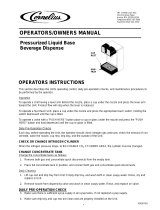 Cornelius none User manual
Cornelius none User manual
-
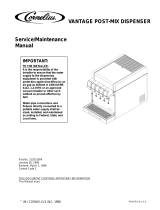 Cornelius VANTAGE POST-MIX DISPENSER User manual
Cornelius VANTAGE POST-MIX DISPENSER User manual
-
 Cornelius Vantage Installation guide
Cornelius Vantage Installation guide
-
 Cornelius Enduro 150 User manual
Cornelius Enduro 150 User manual
-
Cornelius ED200_250 User manual
-
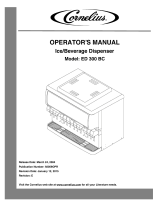 Cornelius Enduro 300 Owner User manual
Cornelius Enduro 300 Owner User manual
-
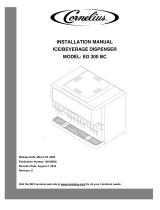 Cornelius ED 300 BC Installation guide
Cornelius ED 300 BC Installation guide
-
Cornelius ED Enduro 200/250 Installation guide
Other documents
-
Sharper Image Impossible to Spill Carrier User manual
-
Summit CR1115 CR1115-ASSY.pdf
-
Summit CR1115 CR1115-ASSY
-
Kegco DT145-3S-630 Template
-
 IMI Cornelius, Inc. ED250 PRO GATE Operating instructions
IMI Cornelius, Inc. ED250 PRO GATE Operating instructions
-
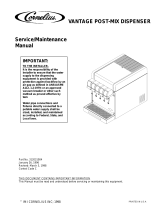 IMI Cornelius, Inc. Vantage User manual
IMI Cornelius, Inc. Vantage User manual
-
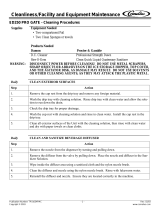 IMI Cornelius, Inc. ED250 PRO GATE Operating instructions
IMI Cornelius, Inc. ED250 PRO GATE Operating instructions
-
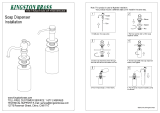 Kingston Brass HSD2618 Installation guide
Kingston Brass HSD2618 Installation guide
-
MULTIPLEX Dual Transformer Installation guide
-
Bunn BUNN-O-MATIC ULTRA-1 Use & Care Instructions











































